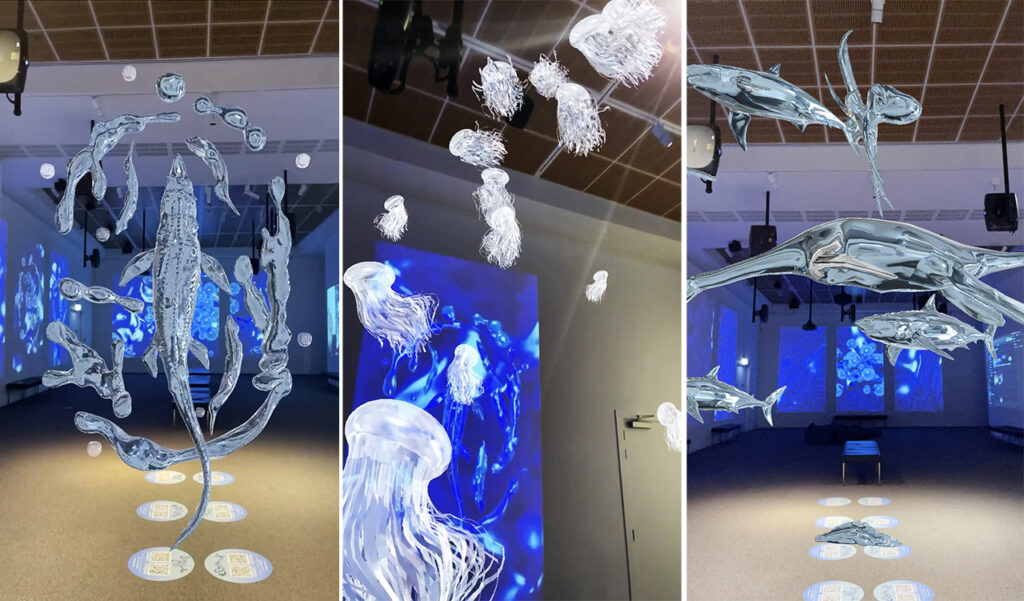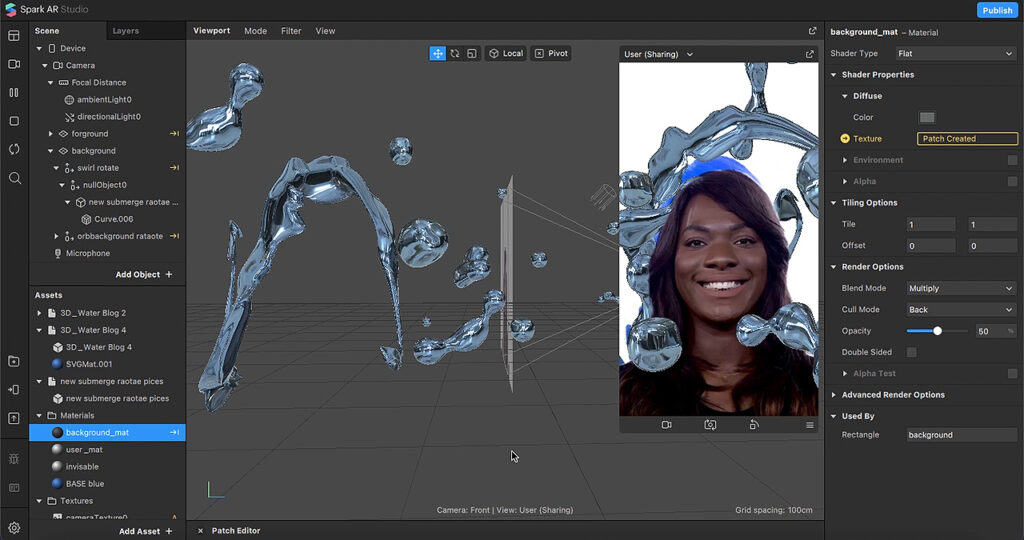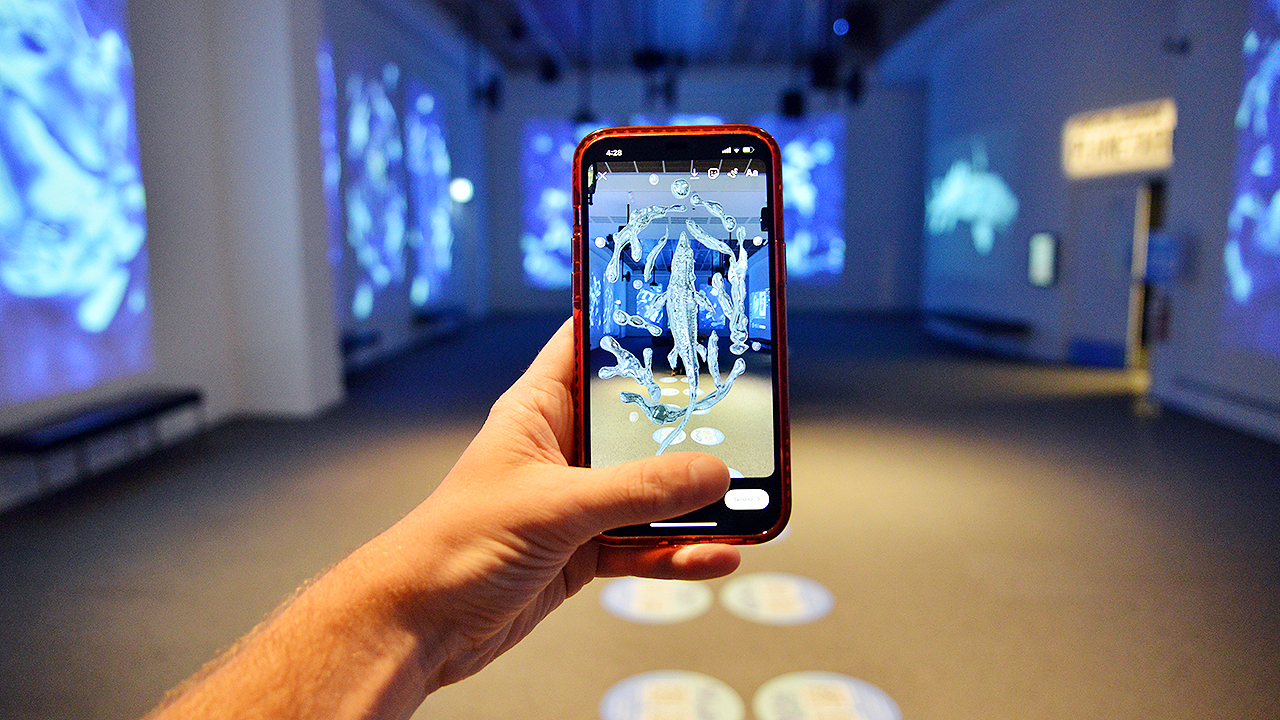Augmented reality (AR) has proven itself over the past two years to be a go-to solution for institutions hoping to engage audiences over lockdowns or to breathe new life into physical exhibitions, particularly to lure visitors back to in-person participation. The Otago Museum’s first interactive AR exhibition, Plunge, is one such program, aimed at enhancing at the experience of the New Zealand venue’s natural science displays.
Running until May 2022, the program invites visitors to scan an onsite QR code with Facebook or Instagram app cameras to discover a virtual aquarium populated by 3D aquatic creatures rendered in glass, chrome, and water textures. But unlike most other AR projects that are created with the help of technology partners, Plunge is solely the product of the museum, having been conceived, produced, and tested entirely in-house.

Otago Museum’s Plunge AR program presents artistic 3D renderings of aquatic animals including sharks and jellyfish, offering visitors a playful and otherworldly experience. Images: Screenshots from Plunge, courtesy of the Otago Museum
Otago’s in-house team may be a lean one, but according to Craig Scott, the museum’s Head of Exhibitions and Creative Services, the four-person crew has about “35 years of museum experience between us.” The team, adds Scott, makes swift work of the design, construction, and interpretation of the venue’s exhibitions. “Our in-house team is the backbone of the museum because we do not normally partner with other firms,” he says. “We all take part in the museum’s other activities, and we work at a very fast pace.”
In fact, Plunge was put together in about a month, demonstrating the kind of agility and in-house expertise that Otago has effectively cultivated for such projects. Below, members of the Otago team discuss how Plunge came together and what it brings to the museum’s programming.
Why the decision to pursue an AR exhibition?
Craig Scott, Head of Exhibitions and Creative Services: We thought we would try and bring something into the gallery that elevates the museum from the regular static experience. The whole work is almost like an art piece in a way… There is nothing like this in the country yet. A lot of our visitors may have heard of AR, but never experienced it. This was entirely a trial and experiment, for us and our visitors.
Why did Otago decide to create Plunge in-house, rather than with an external partner?
Kate Otkay, Marketing Manager: We decided to do Plunge in-house ultimately because of funding — a partnership was just not possible now because we are only partially funded. We also have amazing talent here and we wanted to take advantage of Max [Mollison]’s AR skills.

Plunge was created and produced by Otago Museum’s in-house team on the Spark AR platform. Image: Otago Museum
Please briefly outline the processes of planning and developing the project.
Max Mollison, Exhibitions and Creative Services Officer: I really focused on making Plunge easy to interact with. It took a bit of figuring out to find the easiest processes for visitors. We wanted to make sure we could attract all age groups and involve as many people in our community as possible. Plunge was made for Facebook and Instagram using Spark AR, a platform that anyone can use. We wanted to inspire our visitors to create their own AR work as well.
What were some challenges encountered during planning and development, and how were they addressed?
Scott: Because we put Plunge together in one month, we did not get to spend a lot of time on sourcing content and information. In future exhibits, we hope to add educational audio and incorporate more storytelling. Creating longer project timelines is a challenge because things move very fast at Otago.
How was the exhibition tested?
Mollison: We used our staff and volunteers! We kept everything in-house and ensured the exhibit worked by having our staff explore Plunge first. It was really a learning experience and experiment for us all.
How does a tech-enabled exhibition like Plunge align with or expand on Otago’s broader digital or audience strategy?
Scott: We’re constantly obtaining feedback as to how people are engaging, and that feedback informs our strategy going forward. Our digital strategy is not set in stone, but it does seem that Plunge has been integral to engaging our younger community members, which is something we will take forward.
Edited by Min Chen



